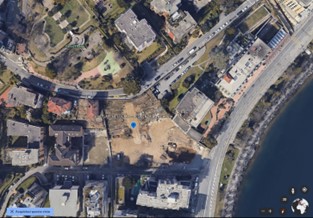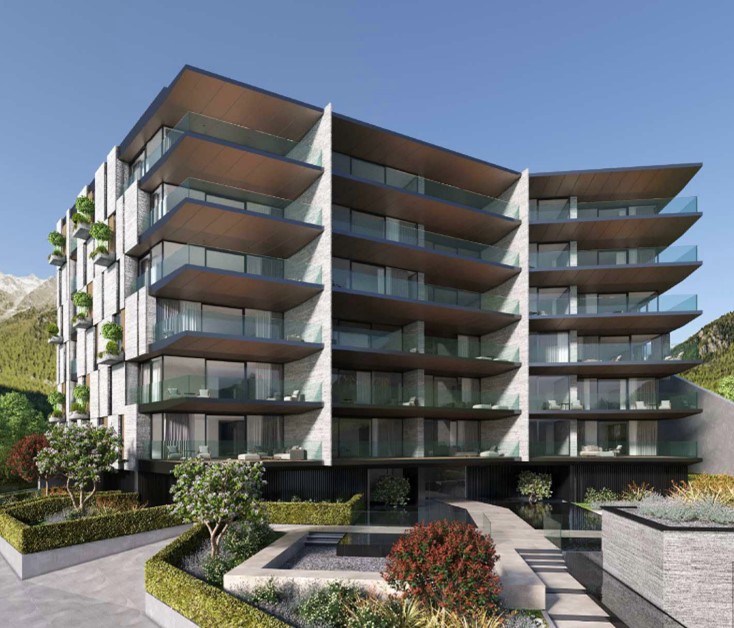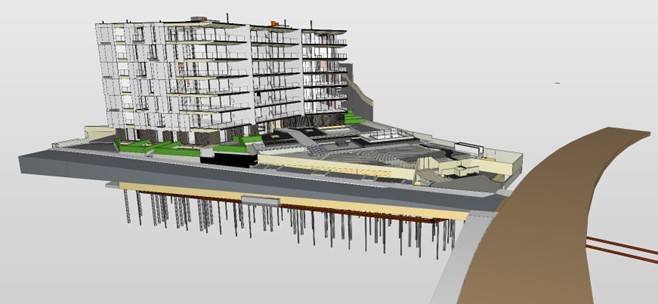AUTHOR: Chiara De Santis
TUTORs: Prof.ssa Paola Ronca
MASTER: Master “BIM Manager” a.a 2022/23
La tesi ha avuto per argomento un ambizioso e innovativo progetto di edilizia residenziale di lusso, in edificazione sulla sponda EST del lago di Lugano, in una zona residenziale di grande pregio.
Il complesso edilizio sarà articolato su un totale di 7 piani fuori terra, da destinare ad appartamenti, e 2 piani interrati da destinare a parcheggi. Il fabbricato architettonico sarà un singolo corpo di fabbrica, di altezza complessiva pari a circa 23 m e avente una superficie coperta lorda di 1385 m2. La copertura, ispezionabile ma non praticabile, sarà dotata di 230 pannelli fotovoltaici per la produzione di elettricità da fonte solare.
La progettazione e la modellazione dell’edificio sono state affidate ad un team multidisciplinare di progettisti, articolato secondo le seguenti competenze:
- Progettazione architettonica, artistica e della facciata (modellazione in ArchiCad),
- Progettazione strutturale (modellazione in Allplan),
- Progettazione impiantistica ed elettrica ( modellazione in Revit MEP),
- Progettazione acustica, antincendio e fisica delle costruzioni (progettazione tradizionale, non BIM)
- Progettazione paesaggistica (progettazione tradizionale, non BIM).
Dal momento che i soggetti coinvolti nelle diverse discipline hanno utilizzato per l’elaborazione dei rispettivi modelli piattaforme differenti software di authoring, il flusso di gestione per il coordinamento e la condivisione dei modelli è avvenuto avviene in modalità OPEN BIM, attraverso lo scambio di formati aperti e non proprietari (IFC, BCF). I singoli modelli disciplinari sono stati utilizzati per assemblare il modello federato dell’edificio.
Nell’ambito dell’organigramma di progetto, l’azienda presso la quale si è svolta la tesi ha svolto un incarico di consulenza per i servizi BIM, con uno specifico focus sui seguenti aspetti:
- Redazione e aggiornamento del BEP (BIM Execution Plan), in particolare definizione degli obiettivi e degli usi dei modelli. Il BEP stabilisce i principali requisiti per la modellazione informativa e ha rappresentato la principale linea guida delle attività svolte durante lo stage.
- Gestione del Common Data Environment di progetto, Autodesk Construction Cloud, in particolare per quanto riguarda la definizione e la gestione dei flussi informativi di commessa. La tesi riporta una descrizione del CDE di progetto e di come sono stati strutturati al suo interno i flussi informativi.
- Model checking e clash detection: ai fini dell’incarico professionale le attività di model checking e di clash detection sono state svolte mediante l’applicativo Solibri Model Checker. È stato effettuato un ciclo di clash detection che ha riguardato due livelli coordinamento: il coordinamento di primo livello, effettuato sui modelli di ciascuna disciplina, e il coordinamento di secondo livello volto a identificare e risolvere incongruenze ed interferenze geometriche tra i modelli di discipline differenti.
- Estrazione di quantità a supporto della redazione di capitolati di appalto, attraverso lo strumento dell’Information Take-Off messo a disposizione in Solibri.
- Supporto nella scelta di una piattaforma di gestione delle informazioni in cantiere: la scelta è ricaduta sul modulo Build della piattaforma Autodesk Construction Cloud.
FOR INTERNATIONAL STUDENTS:
The case study of the thesis was an ambitious and innovative luxury residential building project, under construction on the EAST shore of Lugano Lake, in a highly prestigious residential area.
The building complex consists of 7 floors above ground, to be used as apartments, and 2 underground floors to be used as car parks. The total height of the building is approximately 23 m and it has a gross commercial area of around 1385 m2. The roof, which can be inspected but not commonly accessible, will be equipped with 230 photovoltaic panels to produce electricity from renewable solar power.
The design and modeling of the building were entrusted to a multidisciplinary team of designers, structured according to the following disciplines:
- Architectural and artistical design and design of the facade (modeling in ArchiCad),
- Structural design (modeling in Allplan),
- Mechanical, electrical, and plumbing design (modelling in Revit MEP),
Acoustics, fire prevention and landscape design are developed with traditional methodologies and are outside of BIM scope.
Since the project involves different disciplines, each one using different BIM authoring softwares for the development of their respective models, the workflow for the coordination and sharing of the models was set to take place in an OPEN BIM framework, via the exchange of open and non-proprietary formats (IFC, BCF). Each single disciplinary model was then used to assemble the federated model of the building.
In the framework of the project BIM organizational chart, the company where the thesis was carried out provides a consultancy service on BIM implementation, the customer being an important construction company who wants to realize their first BIM project. The activities of the thesis included but were not limited to the following aspects:
- Drafting and updating the BEP (BIM Execution Plan), with a specific focus on the definition of the BIM goals and the Model Uses. The BEP establishes the main information requirements for BIM modeling and represents the main guideline of the activities carried out during the internship.
- Management of the Common Data Environment for the project (Autodesk Construction Cloud), including the definition and management of the approval workflows. The thesis provides a description of the CDE adopted for the project and streamlines how the workflows were structured within it.
- Model checking and clash detection: quality assurance activities were carried out using Solibri Model Checker software. The first clash detection cycle was performed, which involved two coordination levels:
- Level 1 of coordination was carried out on each single model to identify clashes and inconsistencies for every discipline,
- Level 2 of coordination aimed at identifying and resolving inconsistencies and geometric interferences between models of different disciplines.
- Quantity Take-Off to support the drafting of tender specifications was performed through the Information Take-Off tool available in Solibri.
- Support in choosing a construction site information management platform: the choice fell on the Build module of the Autodesk Construction Cloud platform.



